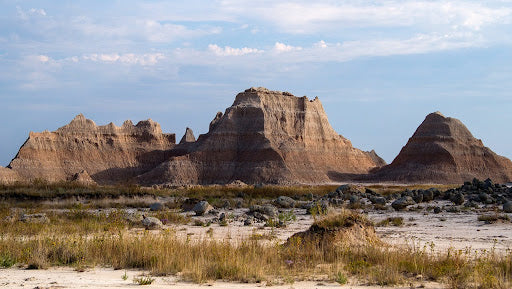The Dakotas are home to three national parks that shouldn’t be overlooked by road-trippers. Whether you prefer to walk through caves, gaze at bison, or explore the history of fossils, there are endless ways to experience these national parks. Start in North Dakota and make your way to South Dakota, or vice versa. No matter where you begin your journey, here’s everything you need to know about exploring the Dakotas in your RV with friends, family, or solo.
Theodore Roosevelt National Park, ND

During prehistoric times, people hunted and gathered on western land in North Dakota and considered the buttes a home to animal spirits. When Theodore Roosevelt was hunting for bison here in 1883, he fell in love with its western landscape, so he developed cattle ranches to promote conservation. In 1901, he used his power as president to protect 230-million acres of this public land. In 1947, President Truman officially named it Theodore Roosevelt National Park—the only national park named after a single individual. There are several sights to see in the park: visitors can drive the 36-mile Scenic Loop Drive to spot bison, walk to the Oxbow Overlook for views of badlands and the Little Missouri River, spot prairie dogs near the Skyline Vista, and much more.
Know Before You Go
All visitors are required to have an entrance pass to get into the park. The park and campgrounds are open year round but some roads may close due to snow. There is nowhere inside of the park to buy food or reserve lodging, so visitors must go outside of the park to find these.
Where to Stay
- Cottonwood Campground – no hookups available
- Juniper Campground – no hookups available
- Roundup Group Horse Campground permits horses – no hookups available
Badlands National Park, SD

Located in South Dakota, Badlands National Park is a place where one of the richest soil beds exist, fossils of mammal species remain, and the biggest mixed-grass prairie in the U.S. is protected. With 244,000 acres and two sections in the park, visitors have endless ways to enjoy this historical landscape. The North Unit is the most visited area in the park. Drive along Sage Creek Rim Road or Badlands Loop Road to spot rugged rocks and wildlife like bison and bighorn sheep. Hike through history along Fossil Exhibit Trail or Pinnacles Overlook. The South Unit is located within the Pine Ridge Indian Reservation and is co-managed by the Oglala Lakota Tribe. During World War II, it’s also where an Air Force bomb range was located!
Know Before You Go
The cost to get into the park is $30 per vehicle and the pass is valid for seven days. Visitors can also get into the park with an entrance pass. In the park, collecting fossils is illegal. Dogs are not allowed in the park and the ground gets very slippery when wet. The park never closes, so visitors are welcome to explore it whenever they’d like.
Where to Stay
- Cedar Pass RV & Campground is the only RV campground in the park – no hookups available
- Badlands/White River KOA Holiday – hookups available
- Badlands Hotel & Campground – hookups available
Wind Cave National Park, SD

How many places in the world have both rolling prairies and one of the most complex caves on the planet? Not many, but that’s what makes Wind Cave National Park a special place in South Dakota. This park is a wildlife lover’s paradise—elk and bison can be seen among the prairies and forests of the Black Hills. There are also over 30 miles of hiking trails, such as the pet-friendly Prairie Vista Trail. The best part? Visitors can book a guided tour to explore the mysteries of the Wind Caves.
Know Before You Go
There is no entrance pass required to get into the park, but tour fees are required for exploring the caves. This park is open year round.
Where to Stay
- Elk Mountain Campground is the only campground in the park – no hookups available
- Custor’s Last Chance RV Park & Campground – no hookups available
- Big Pine Campground – hookups available
If you’re looking to experience something unique on your national park journey, then the Dakotas are the place to go. There aren’t many other places in the country that offer up-close encounters with bison, acres upon acres of protected prairies, and views of breathtaking badlands and ancient caves. If you find yourself drawn to explore the east coast as well, be sure to add the Carolinas to your 2024 bucket list too!
See you on the road!






Share:
5 National Parks in the Southeast Region
5 Reasons to Explore Rocky Mountain National Park in 2024
1 comment
FYI: Wind Cave is closed to underground visitors through September due to an out of order elevator.
Why not include other great destinations like Devils Tower, Custer State Park and Wall?